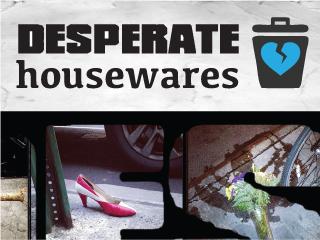Desperate Housewares
Sheiva Rezvani
A mobile app for sharing photos of free things on the street. A fun and more efficient curb alert system. A missed connections for things.
http://www.desperatehousewares.com

Desperate Housewares exposes the little-known lives of objects teetering on the edge of being discarded. Suspended in a curbside purgatory, will they get a second chance? Will someone respond to their urgent cries for a new home? FREE. BARELY USED. BROKEN.
Desperate Housewares : an emotional internet of things.
This mobile app is a space for users to share photos of things found on the street and attach auto-generated stories to them. The app not only helps those who are looking for free things on the street but invites users to engage in a creative space that brings those objects to life.
Background
My initial research & inspiration around the Great Garbage Patch is documented in great detail at: www.greatgarbagepatch.com
Along the way I've looked at examples of how text & stories can influence perceived importance and value of objects (i.e. the book: Significant Objects). I also worked on parsing text using Python, specifically looking a linguistic corpus of 20 years worth of soap operas: http://corpus2.byu.edu/soap/ I eventually landed on Missed Connections as my go-to text: http://newyork.craigslist.org/mis/
I'd been working on developing the main concept around this app in a few classes over the last few years, namely Mobile Me(dis), Social Activism Using Mobile Technologies, and Mobile Web. In those classes we utilized a range of mobile development tools: coding for native android apps using java and eclipse, Appcelerator and Phonegap. In the end, I landed on using Phonegap for my thesis (html, css, javascript).
Conceptually, I was really interested in designing a safe anonymous space similar to Post-Secret in nature, which is why I eventually gravitated towards Missed Connections as the most appropriate text to generate stories from.
Since I first started developing the app concept a few years ago, some big players have emerged in the mobile-photo space, namely Instagram. For the development of the actual app, I worked on utilizing the Instagram API to pull in photos tagged #curbalert
A large chunk of my thesis involved user testing and research reiteration of design based on that research. Most of my resources on user testing methodology came from Katherine Dillon's class, User Experience Design: http://itp.nyu.edu/~kd49/ux/
Also, we learned about this fantastic prototyping tool proto.io in the class Always On Always Connected. It was vital in my user testing.
Implementation
See above.
Background
My initial research & inspiration around the Great Garbage Patch is documented in great detail at: www.greatgarbagepatch.com
Along the way I've looked at examples of how text & stories can influence perceived importance and value of objects (i.e. the book: Significant Objects). I also worked on parsing text using Python, specifically looking a linguistic corpus of 20 years worth of soap operas: http://corpus2.byu.edu/soap/ I eventually landed on Missed Connections as my go-to text: http://newyork.craigslist.org/mis/
I'd been working on developing the main concept around this app in a few classes over the last few years, namely Mobile Me(dis), Social Activism Using Mobile Technologies, and Mobile Web. In those classes we utilized a range of mobile development tools: coding for native android apps using java and eclipse, Appcelerator and Phonegap. In the end, I landed on using Phonegap for my thesis (html, css, javascript).
Conceptually, I was really interested in designing a safe anonymous space similar to Post-Secret in nature, which is why I eventually gravitated towards Missed Connections as the most appropriate text to generate stories from.
Since I first started developing the app concept a few years ago, some big players have emerged in the mobile-photo space, namely Instagram. For the development of the actual app, I worked on utilizing the Instagram API to pull in photos tagged #curbalert
A large chunk of my thesis involved user testing and research reiteration of design based on that research. Most of my resources on user testing methodology came from Katherine Dillon's class, User Experience Design: http://itp.nyu.edu/~kd49/ux/
Also, we learned about this fantastic prototyping tool proto.io in the class Always On Always Connected. It was vital in my user testing.
Implementation
See above.


